This carte-de-visite is part of a series called “Costumes de Suisse,” published around 1869 by French photographer Adolphe Braun (1812-1877). Braun’s studio was in Alsace, France, in the village of Dornach, near the borders with Germany and Switzerland. Each photo in the series presents a young woman in a traditional costume from a particular Swiss canton. This photo is labeled CANTON DE FRIBOURG (PARTIE ALLEMANDE), meaning it presents a costume from the German area of the Canton de Fribourg.

When I saw this carte for sale online, my eye was drawn first to the young woman’s elaborate headdress, then to her dress, then to the lace in front of her. Then my gaze drifted up to the mirror, and I was surprised to see a man’s figure there, undoubtedly that of Adolphe Braun. His face isn’t visible, but his torso is neatly framed by the oval mirror. This was no accidental self-portrait!


The J. Paul Getty Museum has a complete set of Costumes de Suisse. Photographies d’apres Nature par A. Braun. The museum’s version of Canton de Fribourg differs slightly from this one. The website has the following description of it:
Portrait of a woman wearing a dress typical of the canton of Fribourg, Switzerland. She stands in front of an open suitcase on top of an intricately carved dresser or sideboard. A lace veil with a dot pattern spills over the sides of the case, and the woman rests one hand on the top and the other on the bottom. A mirror with an ornately carved frame hangs on the wall above the suitcase, and a painted backdrop that hangs in an open doorframe behind the woman depicts a valley landscape and the surrounding mountains.
Surprisingly, the museum doesn’t mention a figure in the mirror. In the Getty’s version of the photo, more lace is visible, and the figure in the mirror is standing more upright:
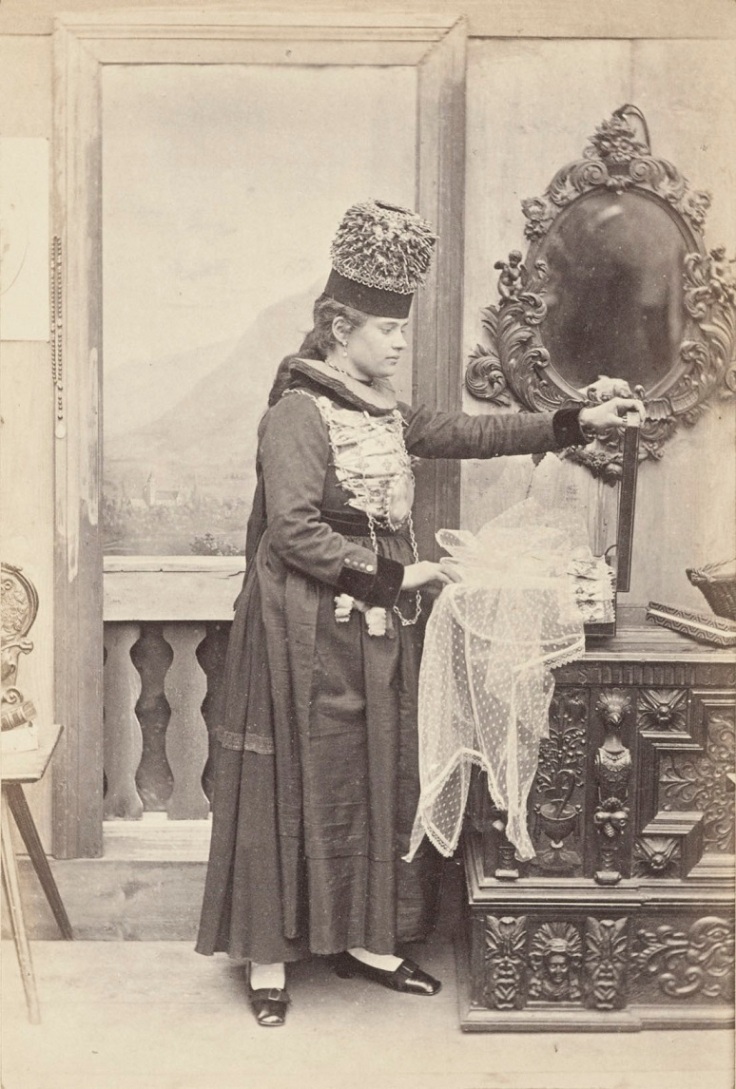

I’ve looked through the other 26 images in the Getty’s set of Costumes, and Braun doesn’t seem to appear in any of them. One contains a mirror, but nothing is visible in it. What was special to him about this one, if anything? Did he have a personal connection to the Canton de Fribourg? Or was he just having a little fun, stepping into the frame for once, instead of always remaining invisible, only a name on a card?

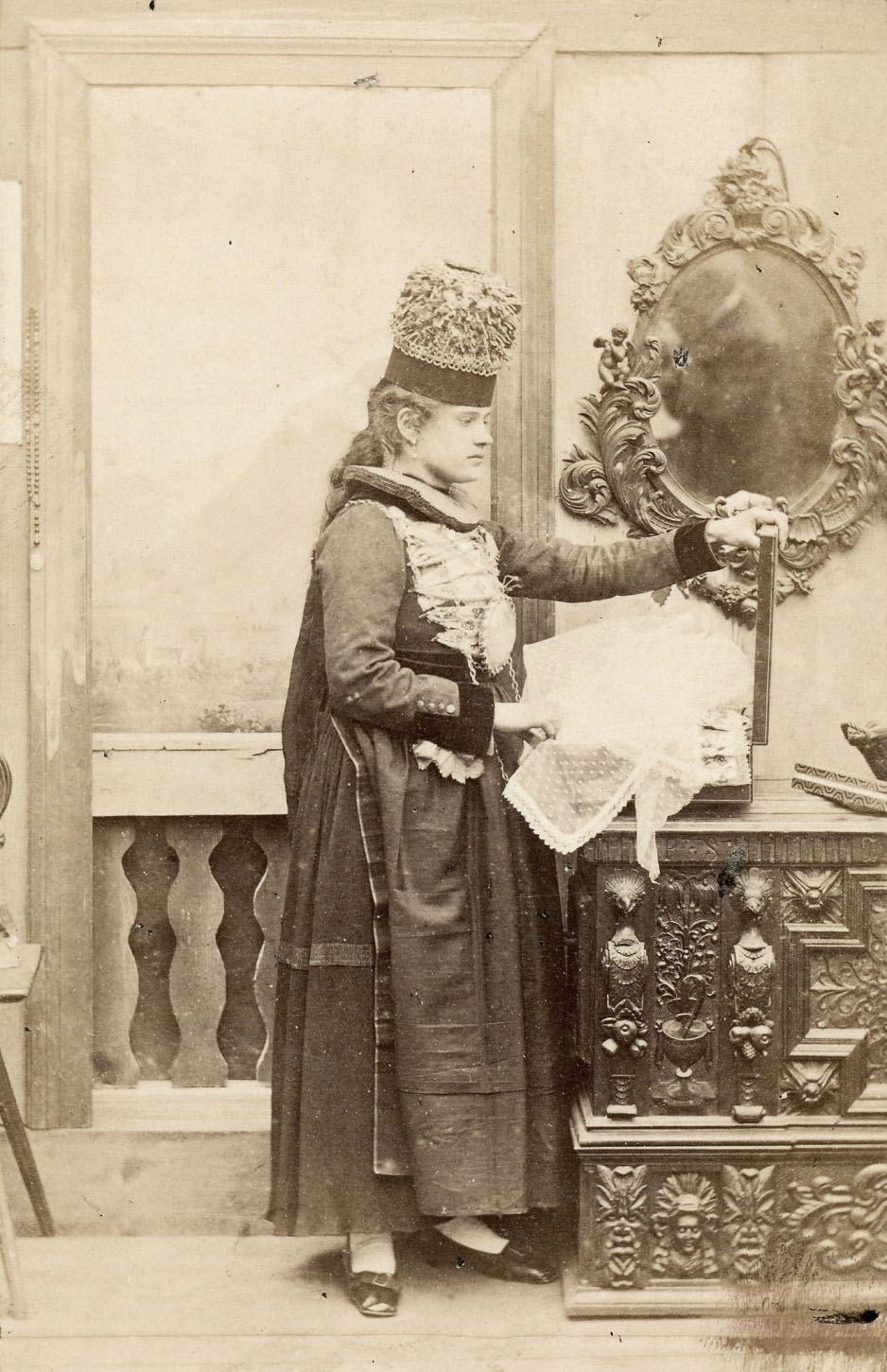
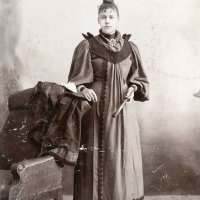
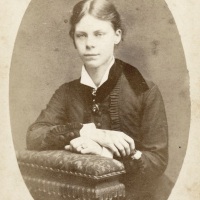
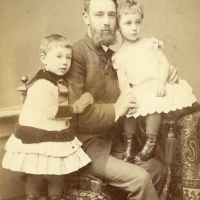
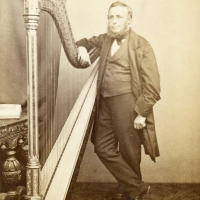
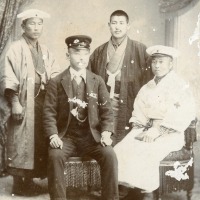
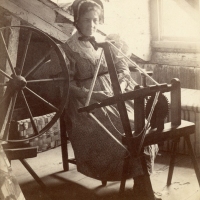
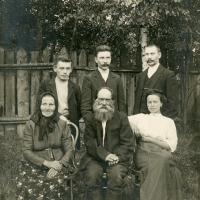
Always fun to find those interesting little things, like the photographer’s image in the mirror. I also noticed it right away and wondered. 🙂
It’s quite an elaborate costume, but it’s amazing how that hat stays on! 🙂
LikeLiked by 3 people
The hat is a mystery! You remind me that I was going to try to find a modern example. 🙂
LikeLiked by 3 people
It’s almost like a big Pill Box Hat. 🙂
LikeLiked by 2 people
Do you have an approximate date for the card? The first, fanciful thought that came to me was that he might have just finished reading “The Picture of Dorian Gray,” which was published in 1890. Or, his image there might have been nothing more than a sly joke.
LikeLiked by 2 people
The Getty says the photo was made “about 1869.” I think he was just having fun by leaving a kind of signature in his work. 🙂
LikeLiked by 1 person
And good for him. We need a little more fun these days, even if it’s old fun!
LikeLiked by 2 people
Kind of like what Alfred Hitchcock used to do?
LikeLiked by 2 people
Very interesting young lady in an amazing dress and a headdress. My attention was immediately attracted by a chest and a mirror. How much time does the master spend on making such a beautiful things? Amazing work!
LikeLiked by 2 people
Thank you! I agree, the dress and headdress are amazing. The real artist was whoever created them! The chest and mirror are also remarkable, and probably were old already in 1869. It’s nice of you to stop by! 🙂
LikeLiked by 1 person
Beautiful photo with an interesting little mystery associated with it! I love the set of photos at the Getty. It shows that art curators aren’t always the most observant folks. Or maybe what they look for is different than what the rest of us look for in a piece of artwork.
LikeLiked by 2 people
In my research, the Getty’s website has frequently been the best place to find information on early European photographers not working in the UK. (The NPG in Britain is the best for the UK.) I was really impressed by how much attention the Getty had given to Braun’s work. They have 712 of his photographs! (Most are probably landscapes.) I was surprised the cataloger didn’t notice the figure in the mirror, but they couldn’t notice every detail in every image. Thanks, Shayne!
LikeLiked by 2 people
A very fascinating photo! I like to think the artist was wondering if anyone would see his image in the mirror. 🙂
LikeLiked by 2 people
I totally missed it until Brad pointed it out!
LikeLiked by 1 person
Thanks, MM and Liz!
LikeLike
I do love the mystery of the photographer in the mirror! Just behind her to the left is a rosary hanging upon the wall. I say rosary because it has the same form and count yet rosaries usually begin at their base with a crucifix and this one seems to have a medal instead. I wonder why it’s there. Wonderful photo!
LikeLiked by 2 people
I’m so glad you noticed the rosary, because I didn’t know what it was! It’s definitely there for a reason. It may be an allusion to Catholic heritage, but that wouldn’t explain the medal in place of a cross. Great eye, Suzanne!
LikeLiked by 2 people
Thanks Brad! I looked up rosaries and they can be made without a crucifix but it’s not common. It occurs to me that there could be a cross within the circular medal that we cannot see. I was thinking and all of this is pure conjecture as my thoughts often go to stories. Several of the details make me wonder if these two are in fact a couple, perhaps even forbidden. The rosary hanging on the wall behind her could be a symbol of how one or the other or both must leave the institution of the church in order to be together. The lace in the open suitcase and the ornate chest remind me of a woman gathering her best to take with her into the journey of marriage. The chest at the ready to hold their few precious possessions and their dreams of the future. And of course the photographer himself, staying hidden but so clearly close at hand, facing her. He is gazing upon her and in a way has made a portrait of them both even though he keeps himself hidden. Why does he find a way to add himself into this particular portrait and none of the others. Maybe….😊
LikeLiked by 2 people
Ever the romantic! ❤️ You tell a convincing tale, dear poet! Now I won’t look at this image the same way again, which is totally fine. 😊 About the medal or token on the rosary, I zoomed in at very high resolution and could see nothing there–it looks completely blank. That could mean that the design on the surface of the token is very subtle and the camera didn’t pick it up. My guess is that it doesn’t have a cross on it, at any rate. Hope you and the pups are having a nice weekend so far!
LikeLiked by 1 person
You said the museum’s version differs slightly from yours. I wonder if there could be further different versions of the same picture and when you line them up in sequence, the final picture will reveal the photographer’s face, that would be fun 😊
LikeLiked by 3 people
Haha, I’ll keep looking! Maybe the final version will have a cat in the mirror, and we’ll know that the cat was the real mastermind behind the camera. 😺
LikeLiked by 2 people
Reading the discussion between you and Suzanne about this mysterious photo, I’m drowned in thoughts.
LikeLiked by 2 people
Thanks for visiting my cabinet of curiosities, Isabelle. 😊
LikeLiked by 2 people
I like the idea of the photographer staging a little “cameo” appearance in this photo, as a previous commenter said, in the style of Alfred Hitchcock.
Also I LOVE this woman’s shoes.
LikeLiked by 2 people
Cameo is the perfect word for it. The mirror even has the shape of a cameo locket.
I’m glad you noticed her shoes. They look much more practical than the rest of her outfit!
LikeLiked by 2 people
Everyone has such fascinating responses! This is a truly intriguing photo for so many reasons. But I can’t seem to draw my attention away from the hat. What on earth is it made of? It looks prickly! National costumes are so bizarre, as we know from earlier posts of yours, Brad! Chaucer’s Prioress wrapped her rosary around her wrist, like a bracelet, and it had a medallion at the end, instead of a cross, with a capital A beginning the inscription “Amor Vincit Omnia.” (Of course, all of this was Chaucer’s sly commentary on the Prioress, whose mind should have been on heavenly love, and not her little dogs, her elegant table manners, and–horrors–“Amor,” earthly love. )
LikeLiked by 2 people
Fascinating, Carol! I love the Chaucer reference!! I still don’t know what the hats were made of, but they were apparently colorful, and pins may have been involved. This image is on Pinterest, but I couldn’t figure out the address of the original source blog:

LikeLiked by 1 person
Fascinating photo, Brad – also its ‘sister’ photos on the Getty site. The image in the mirror is either deliberate and of the photographer, in which case he’s either done it with mirrors or cleverly added it in a vintage version of post-production as he can’t have been in two places at the same time – facing her to have his image in the mirror as he’s photographing her… or else it’s of someone else in the room – possibly an assistant, maybe someone in charge of some of the lighting?
The other version on the Getty site is different in several ways of which I’ve noticed the following: her eyes and hand are in a slightly different position, the reflection in the mirror is more upright than in your photo, the striped part of her dress (possibly a ribbon or wrap?) is missing in the other version – hidden behind a fold of the skirt or completely absent. There is more lace hanging down in the Getty version. I hadn’t realised that she was holding open a case – her hand resting on the edge of the lid – presumably meant to be a bridal trousseau.
The way her hat is balanced, I’d assume that some of her hair is piled up on top of her head to hold it on, in the way that the huge Victorian hats were held on by similarly huge hair styles! The rest will have been held on with hair pins – very very long and dangerous ones! 🙂
LikeLiked by 2 people
How interesting that the long vertical stripe on her dress in my version of the photo is completely absent in the Getty’s version. I hadn’t noticed! It could be accidental, but my guess is it was intentional; Braun may have been unsure whether the dress would look better with the stripe or without. You have an amazing eye for details!
LikeLiked by 2 people
So fascinating!!
LikeLiked by 1 person
Blog visitor George Chaney has a hand-tinted print of the version of the photo in the album at the Getty Museum. Hand-tinting was a common practice in the 19th century and was usually done by young women working in a back room of a photography studio. Thank you, George!

LikeLike
What a hat!
LikeLiked by 1 person
It’s pretty remarkable!
LikeLiked by 1 person
I wonder what it represented or was it just cultural for a region?
LikeLiked by 1 person
That’s a great question. I think it was a regional variation.
LikeLike